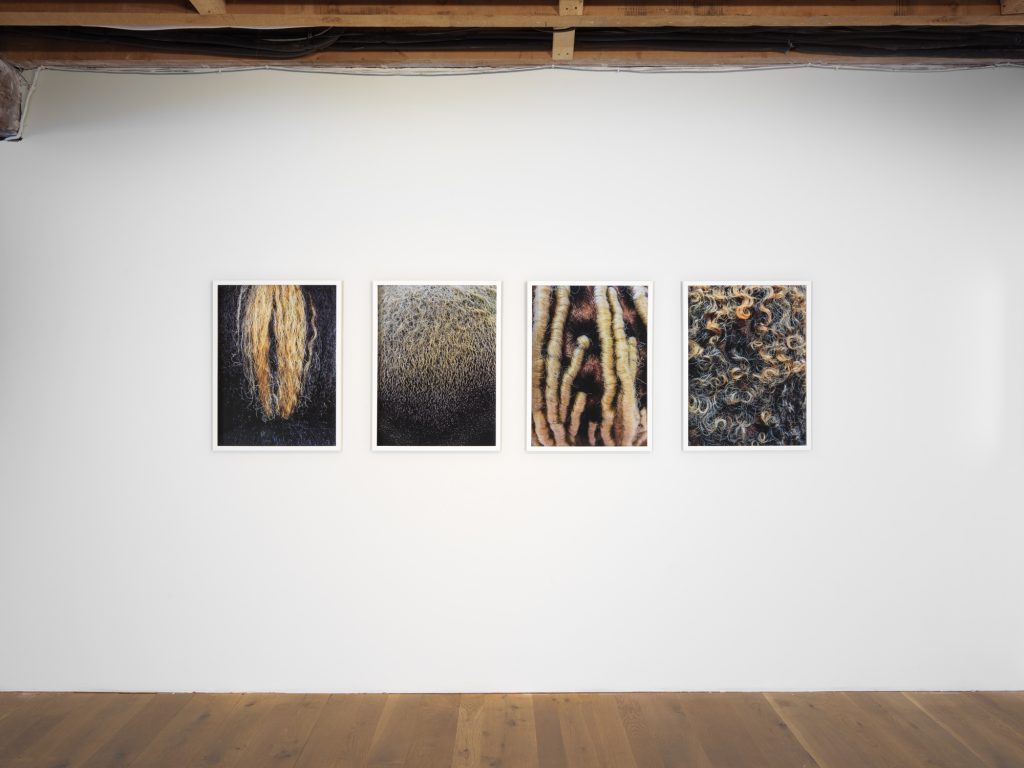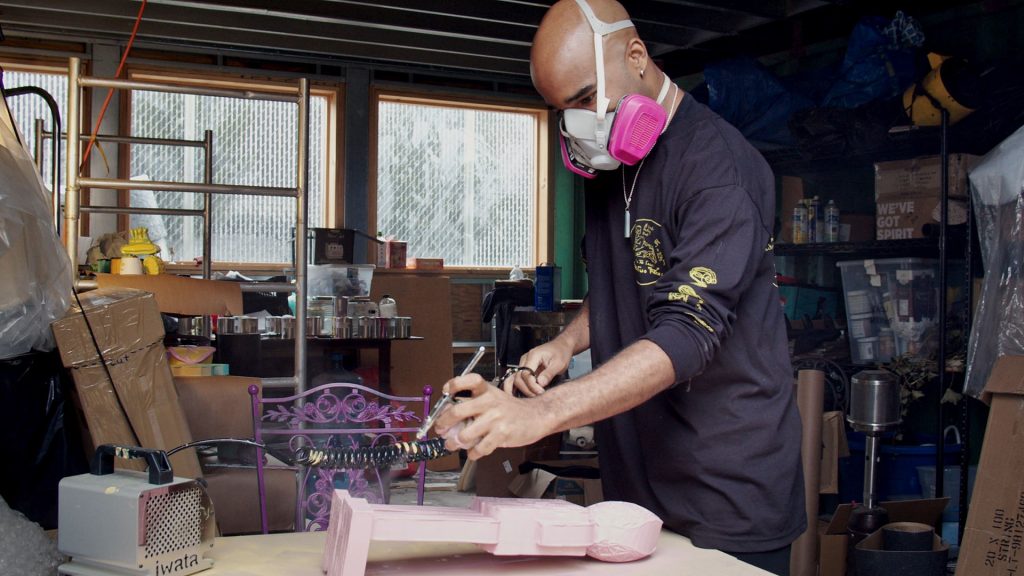Identity Communicated Through Color in Two Exhibitions at Pioneer Works
John Lucas, Claudia Rankine and Matthew Morrocco address blonde hair and queer identity respectively, through photography and sound

Modern technology has created a system of surveillance due to most everybody being armed with a camera. The constant occurrence (some might say assault) of having one’s image taken and spread across social media has further exalted certain markers of appearance, while deeming those with attributes that do not align as “other.” Blonde hair and queer identity have been hyper-scrutinized in the modern political climate—one as aspirational, the other as disdained. Two concurrent exhibitions at Pioneer Works, Orchid: RGB by Matthew Morrocco and Stamped by John Lucas and Claudia Rankine, take these elements to the white walls of the gallery space and examine them under a closer lens.

Bright, saturated colors pour out from the photographs by Morrocco. In comparison, the pulsating iPhone live photos of blonde roots by Lucas—paired with the soundscapes of Rankine—create a world of close-perspective splendor. Both of these shows center around concepts of identity communicated through its association to color. Both operate in conversation with one another, exploring opposite sides of the same spectrum. In Morrocco’s work, the subject is covered in monochrome colored spandex to conceal the human and display only the form of the body. Still, a queer subject is called forward, freed from any other identity to drift gracefully through one component of the RGB spectrum.

In opposition to this type of invisibility that Morrocco invokes, the work of photographer and documentarian Lucas and multimedia artist and poet Rankine explores the visibility blonde hair demands. (The societal, cultural and historical implications of blonde hair—youth, beauty, the shadow of eugenics—and other schools of thought superseded by choice.) They also touch upon the idea of reclamation of one’s identity through the use of chemical mediation. This allows “blondness” to move beyond its association as a racially charged status marker, creating room to rethink our associations with the golden color and reimagine it in terms of the “complicit freedom” that the artists suggest.

Morrocco’s Orchid: RGB includes a photography series exploring his “Orchid,” a queer figurative subject that blooms across the surface of the works. The inventive curation by David Everitt Howe ties the pieces in this series together under a central spectrum that operates as one cohesive concept. The display of the photography points out the clear influence from works by painter Ellsworth Kelly, creating an enthralling experience of synesthetic bliss while retaining a sense of seamless coordination. The photo montage on the neighboring wall displays another series of images framed to resemble hands gripped to the screen of a tablet. These works capture the same exploration of self-portraiture, while collaborating with the mechanical eye that is capturing the scene.

These works, inspired from Dziga Vertov’s The Man With the Movie Camera (1929), provide focus to the camera that is capturing the work while modernizing the perspective to include the technological advancements that have ingrained themselves into everyday interactions. iPhones, iPads, and other devices have replaced the personal camera and filter our reality to create a distinct frame and technological residue that is complicit to his works.
Queerness is really illusive right now… I think that this opening up of it that is occurring now needs to occur more and more to incorporate things like feminism, and blackness, and trans-ness
Morrocco describes his thoughts on what queerness means in his work during a speaker series, moderated by Hunter O’Hanian Director of the Leslie-Lohman Museum for Gay and Lesbian Art. There he states that “Queerness is really elusive right now… it has this identity that is kind of mainstream but also this other more academic identity that I think is at odds with each other… it has become something more exclusive, especially in terms of its academic identity.” Morrocco adds, personally, that “the history of it and the use of it in my life, my identity, and especially my work has always felt really important, but I think that this opening up of it that is occurring now… needs to occur more and more to incorporate things like feminism, and blackness, and trans-ness.”

He continues, “How do we open up queerness to make those things more inclusive and make it as more globalized or holistic sensibility that can be about what the essence of queerness actually is, which is being inclusive and making people feel at home and making people feel comfortable. That’s what queerness is. It’s about reaching out and finding things that people don’t want to look at and making sure that they look at them and making sure that everything is beautiful.”

Erstwhile, Rankine and Lucas’ show goes into and beyond the racial associations with blondness. This correlates with Rankine’s involvement in The Racial Imaginary Institute in New York, which she helped to found with her MacArthur award grant money. Their collaborative art is in conversation with the racial implication of blonde hair upon blackness and the oppressive whiteness that has been cast as the standard. The artists play with these ideals while centering the work on something that extends beyond race itself. The show is a transformative, immersive space using photography, video, sound, and wall text installations to create a compelling firsthand experience. The use of text on the windows allows one to see the outside world with the imposition of “blondness” cast down. The video installation of iPhone live photographs breathes life throughout these images, placing the haptic resonance of the shaking hand holding the phone’s frame in direct context to the work.

The postage stamps with close-up images of hair—roots grown out to show the separation from the subjects’ natural and bleached hair—signifies material worth. Gazing at the large unseparated print of hundreds of stamps made with the image of blonde hair is a sensory overload, forcing the viewer to come close and engage with the minute images. Sound installations of Rankine interviewing blondes at grocery stores, airports, Brooklyn’s Afropunk Festival, and the Republican National Convention in Cleveland are played, interrupted with the Lady Clairol ad telling the listener “It’s true, blondes have more fun.”

The fetishization of blonde hair has clear ties to Hollywood film culture, while also pointing back to art historical contexts of work by Santiago Sierra “133 persons paid to have their hair dyed blonde” (2001) for which Sierra paid 133 illegal street vendors, mostly immigrants, to have their hair dyed blonde in a warehouse, highlighting their presence to the visitors of the Venice Biennale.

The works in both exhibitions point out key questions about how we live in modern times, propelling the past into the present through the experiences of the artists. Both shows run through 26 August at Pioneer Works.
Images courtesy of Pioneer Works













What are your thoughts?